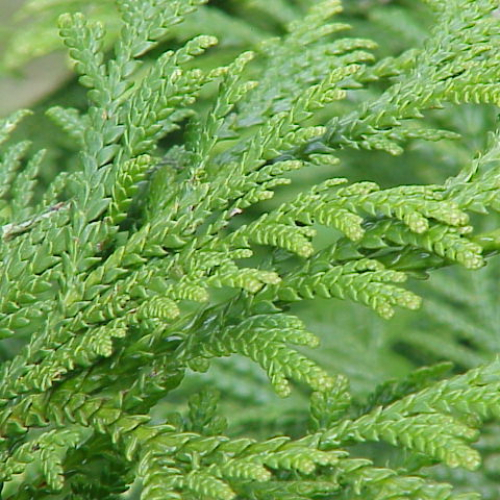Coniferous Tujоpsis

Description
Characteristic Features of Thujopsis
Thujopsis is a genus of highly ornamental conifers in the cypress family Cupressaceae. In the wild, this plant is found in the rainforests of Japan. There it was considered a sacred plant and is still planted around temples.
The genus Thujopsis is represented by a sole species, Thujopsis dolabrata also called Hiba, False Aborvitae, or Hiba Arborvitae. This evergreen plant resembles Thuja, as its name suggests. The Greek word "thujopsis" means "Thuja-like."
Thujopsis reaches a height of 10-30 metres and has a broad crown; a straight trunk with red-brown thin bark, flat branches arranged horizontally; scale-like, leathery needles, typically green on the upper surface and featuring white spots on the underside (the needles resemble small hatchets), and rounded cones with oval light brown seeds and two wings.
The needles give off a pleasant fragrance when crushed in hands. Due to this, the shoots are used to produce essential oil for perfumery. In Japan, Thujopsis dolabrata has two varieties, australis and hondai that differ mostly in the size and arrangement of branches. The australis species is a small tree with a thin trunk and a pyramidal crown, while hondai grows up to 30 meters tall and has dense pine needles and small branches.
Thujopsis species cultivated as ornamental plants are mostly shrubs or small trees up to 1.5 metres tall. Currently, the most popular varieties are the following:
'Robusta', a fast-growing high tree;
'Aurea', a beautiful tree with golden-yellow needles;
'Aurescens', with golden-orange needles;
'Altissima', with a columnar crown and short shoots;
'Plicata', with lush foliage and fan-shaped branches;
'Cristata', with comb-like shoots;
'Decumbens', with drooping branches;
'Variegata' that reaches a height of 15 metres and has a pyramidal crown and variegated branches and needles;
'Graciosa', a low-growing plant with loose branches;
'Nana', a slow-growing shrub about 60 centimetres tall, with thin branches and small needles.
Due to the fact that, despite being heat-loving, Thujopsis is quite winter hardy, its cultivation started in various European regions already in the 19th century. Moreover, currently low-growing varieties of this attractive tree are grown as houseplants. Indoors, Thujopsis thrives in cool bright locations. In the summer, it is best to move it to a balcony or porch. In the garden, Thujopsis looks good both in single and group plantings. The best companion plants are pines, firs, larches, willows, oaks, and other trees. Thujopsis looks perfect close to stones, especially boulders. A Japanese garden cannot be imagined without this plant. Thanks to its unique needles, Thujopsis is a favourite and the most popular conifer.
The Secrets to Successfully Growing Thujopsis
This plant prefers fertile soils (especially loam, both acidic and alkaline) with enough moist and good drainage. It thrives in partial shade or in full sun in a location protected from cold winds. Thujopsis loves humid air so it is often planted near water.
In the garden, Thujopsis is grown from seedlings. Plant the seedling in mid-April or early summer. Dig a hole 60-70 centimetres deep, put a layer of bricks 15 centimetres deep, and position the plant together with a ball of earth. Keep the root collar at ground level. The most suitable soil is a mix of humus, compost, and sand. It is good to make in phosphate fertilizer. When planting the plants in groups, space them 50 centimetres to 1.5 m apart, depending on variety.
The basic care includes regular watering (about 10 litres of water per mature plant) after the top soil dries off 5 centimetres deep, misting, and feeding with Kemira Universal once every 2 years in the spring. Loosen the soil, if it is too dense.
Thujopsis is not hardy. Only mature trees can withstand temperatures down to -23 ° C. In moderate climates, its shoots are often damaged by frost but will be restored. Winter shelter the plants, especially young ones, with spruce branches and leaves or mulch with a 5 to 10 centimetre layer of peat.
Prune only when necessary to shape a crown.
Thujopsis is propagated by seed, cuttings, or grafting.
Stratify the seeds for 3-4 months to improve germination. Sow in containers with moist fertile soil. Keep the seedlings in a bright location at about 20 ° C and regularly water. After germination, prick out the seedlings. In the summer, move young plants to the garden for hardening and then plant in open ground. If the seedlings are still weak, you can leave them in containers for the winter and transplant to a permanent location next spring. However, seed method is complicated by the fact that the plants in cultivation rarely bear fruit, therefore, as a rule, gardeners resort to propagation by cuttings. The best time to so it is March. Root the shoots (short lateral branches) in the greenhouse in high humidity and room temperature conditions. It is best to use growth promoter.
Potential Problems
Thujopsis is sometimes damaged by spider mites that make webbings on the underside of the needles. Yellow spots appear on the upper part of the needles. If you detect infestation, treat the plant with acaricides.
Even a greater problem for Thujopsis can be Coccidae and scale insects sucking the sap out of the needles, which causes needle yellowing and curling. Immediately remove the pests from the plant, otherwise it will die. Once established, the pests are hard to control as adult scale insects are protected by hard shell layers, so just spraying with insecticide is not sufficient. Manually remove the pests with a brush moistened in chemicals by cleaning the upper surface and underside of each branch.
Failure to comply with the watering schedule can lead to root rot. The plant should be transplanted as soon as possible. Remove the damaged roots and treat the plant with fungicides.







 5 351
5 351








